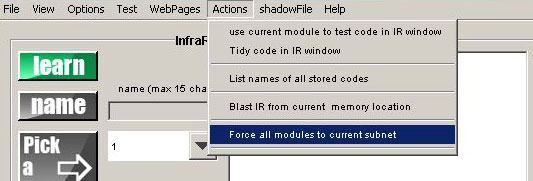IP addresses & Connection
Once the Java program has been launched it scans the network to find any Modules present. The status in the lower LH corner will change as soon as any modules are found. To see detailed information, select the "options" menu and check the "show all activity in activity window". You will then be able to see a log of the discovery packets within the activity window. As soon as a module is found you will be able to see the Hostname, MAC address, IP address and other detailed information.
If a module is found that is on a different subnet to the computer running the Java program a warning will appear and present you with the options to enable DHCP or force the module to the current subnet.

If you leave the module on a different subnet without taking any further action you will be unable to view the web pages from that computer.
If the module IP is NOT displayed then from the Actions menu choose "force all modules to current subnet").

This should only need to be used if your network does NOT use DHCP and you have attached the modules to a network with a address that is not 192.168.1.xxx.
Assume your local network has a 10.0.0.xxx base. You do not use DHCP and you have attached the modules.
Your PC will not be able to see them because they are on a different subnet. If you now press the change subnet button all of the IP addresses used by ALL ATTACHED MODULES will be changed to match your network. The default address for a target module is 192.168.1.31. This will be changed to 10.0.0.31. The gateway will be changed to 10.0.0.1 etc. By typing http://target into your browser bar you should now be able to reach the module as it is in the same subnet and then able to configure the module as required.
Once you have the status window correctly displaying the IP address of the IR Commander you can safely progress on to the Learning IR Code stage.